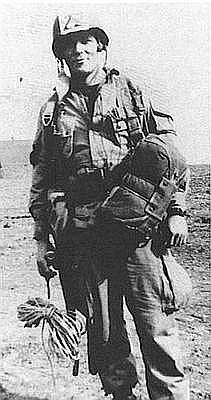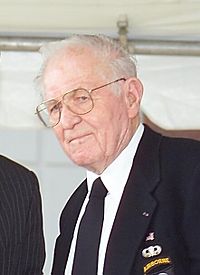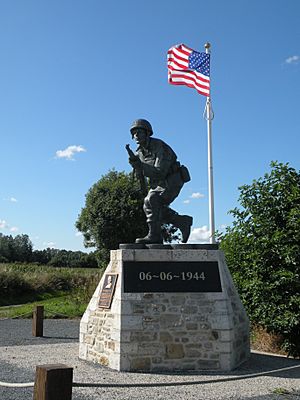Richard Winters facts for kids
Quick facts for kids
Richard Davis Winters
|
|
|---|---|
| Nickname(s) | "Dick" |
| Born | January 21, 1918 New Holland, Pennsylvania, U.S. |
| Died | January 2, 2011 (aged 92) Palmyra, Pennsylvania, U.S. |
| Place of burial |
Bergstrasse Cemetery
Ephrata, Pennsylvania, U.S. |
| Allegiance | United States |
| Service/ |
United States Army |
| Years of service |
|
| Rank | Major |
| Service number | 0-1286582 |
| Commands held | 2nd Battalion, 506th Parachute Infantry Regiment, 101st Airborne Division |
| Battles/wars | World War II |
| Awards | Distinguished Service Cross Bronze Star Medal (2) Purple Heart Croix de Guerre (France) Croix de Guerre (Belgium) |
| Spouse(s) |
Ethel Winters
(m. 1948) |
| Children | 2 |
| Relations | Richard (father) Edith (mother) |
| Other work | Businessman, guest lecturer |
Richard Davis Winters (January 21, 1918 – January 2, 2011) was an American soldier and businessman. He is famous for being an officer in the U.S. Army during World War II.
Winters led a group of soldiers known as Easy Company. This company was part of the 2nd Battalion, 506th Parachute Infantry Regiment, which belonged to the 101st Airborne Division. He eventually became a major and took command of the entire 2nd Battalion.
As a first lieutenant, Winters parachuted into Normandy on June 6, 1944. He then fought bravely across France, the Netherlands, Belgium, and Germany. After Germany surrendered in May 1945, he helped oversee the return of soldiers home. In 1951, during the Korean War, Winters was asked to return to the Army. He served briefly before leaving the Army for good.
Winters' story and the experiences of Easy Company have been shared in many books. He was also played by actor Damian Lewis in the 2001 HBO mini-series Band of Brothers.
Contents
Richard Winters' Early Life and Education
Richard Winters was born in New Holland, Pennsylvania, on January 21, 1918. His family later moved to Ephrata and then to Lancaster. He finished high school in 1937 and went to Franklin and Marshall College.
At college, Winters was part of a fraternity and played intramural football and basketball. He worked part-time jobs to pay for his studies. In 1941, he graduated with a degree in Economics. He was the top student in his business program.
Winters' Military Service in World War II
Joining the Army and Training

Winters joined the Army on August 25, 1941. He later wrote that he joined to fulfill a one-year service requirement. He wanted to avoid being drafted later into a longer war.
He completed his basic training in South Carolina. In April 1942, after the United States joined World War II, he was chosen for Officer Candidate School (OCS). He became friends with Lewis Nixon there, who would serve with him throughout the war. Winters became a second lieutenant in the infantry after graduating in July 1942.
Winters decided to join the parachute infantry, which was a new part of the U.S. Army. He later joined the 506th Parachute Infantry Regiment (506th PIR) at Camp Toccoa in Georgia. This regiment was led by Colonel Robert Sink.
Winters arrived at Camp Toccoa in August 1942. He was assigned to Company E, 2nd Battalion, 506th PIR. This unit became known as "Easy Company." Winters became a platoon leader and was promoted to first lieutenant in October 1942. The training at Toccoa was very difficult. Only a small number of volunteers completed the course.
In June 1943, the 506th PIR joined the 101st "Screaming Eagles" Airborne Division. Later that year, they traveled to England to train for the Allied invasion of Europe.
Leadership Challenges and Changes
In late 1943, there were problems between Winters and his commanding officer, First Lieutenant Herbert Sobel. Winters and many soldiers felt that Sobel was not ready to lead them in combat. Sobel tried to charge Winters with not following orders. Winters asked for a review of the charge.
Winters was temporarily moved to another unit. Several non-commissioned officers (NCOs) in Easy Company threatened to resign if Sobel was not replaced. Colonel Sink, the regimental commander, realized he needed to make a change. Sobel was transferred out of Easy Company. Winters returned to Easy Company as a platoon leader. In February 1944, First Lieutenant Thomas Meehan took command of Easy Company.
Summer 1944: D-Day and Beyond
Meehan led Easy Company until the invasion of Normandy. On June 6, 1944, the plane carrying Meehan and his headquarters section was shot down. Everyone on board died. Winters had parachuted safely nearby.
Winters quickly gathered other paratroopers and headed towards their objective. With Meehan's fate unknown, Winters became the leader of Easy Company. He remained in command for the rest of the Normandy campaign.
Later that day, Winters led an attack on a German battery of 105mm howitzers. These guns were firing on the main exits from Utah Beach. Winters had only 13 men, while the Germans had about 50. This attack, known as the Brécourt Manor Assault, was a huge success. It is now taught at West Point as an example of a perfect assault. Winters also captured a map showing German gun positions near Utah Beach.
On July 1, 1944, Winters was promoted to captain. The next day, he received the Distinguished Service Cross. This is the second-highest award for combat bravery. Soon after, the 506th Parachute Infantry returned to England.
Autumn 1944: Operation Market Garden
In September 1944, the 506th PIR parachuted into the Netherlands as part of Operation Market Garden. This was a large airborne and armored operation. On October 5, 1944, German forces attacked the 2nd Battalion. Winters led a small squad to attack a German machine gun position. They then faced a larger German force, which Winters also successfully attacked. It was later found that there were at least 300 Germans.
On October 9, Winters became the executive officer (XO) for the 2nd Battalion. This position was usually held by a major, but Winters filled it as a captain. The 101st Airborne Division was then moved back to France.
Winter 1944-45 and Spring 1945
On December 16, 1944, German forces launched a surprise attack in Belgium. This started the Battle of the Bulge. The 101st Airborne Division was sent to Bastogne. Winters, as the 2nd Battalion's XO, helped defend the area. The 101st Airborne and other units fought against about 15 German divisions for nearly a week. Finally, General George Patton's U.S. Third Army broke through the German lines.
After the battle, the 2nd Battalion attacked Foy on January 9, 1945. In March 1945, Winters was promoted to major. He then became the acting commander of the 2nd Battalion.
In April, the battalion performed defensive duties along the Rhine River. In early May, the 101st Airborne Division was ordered to capture Berchtesgaden. Winters' battalion reached the area on May 5, 1945. Three days later, the war in Europe ended.
After the War: Awards and Return Home
After the war, Winters stayed in Europe to help with the occupation and sending soldiers home. He was offered a permanent commission in the Army, but he turned it down. He finally left the Army on November 29, 1945.
Winters was recommended for the Medal of Honor for his actions at Brécourt Manor. However, he received the Distinguished Service Cross instead. After the Band of Brothers TV series came out, there was an effort to get him the Medal of Honor, but it did not pass.
Korean War Service
After World War II, Winters worked for his friend Lewis Nixon at his family's business. In May 1948, Winters married Ethel Estoppey. He also continued his education using the GI Bill.
In June 1951, Winters was called back to active duty during the Korean War. He tried to convince the Army not to send him to Korea, explaining he had seen enough war. He was then assigned as a planning and training officer at Fort Dix, New Jersey.
Winters found his new job unfulfilling. He volunteered for Ranger School and passed. He then received orders to go to Korea. However, before deploying, he was given the option to resign his commission, which he accepted.
Richard Winters' Later Life and Legacy
After leaving the Army for good, Winters became a production supervisor at a plastics business. In 1951, he and his wife bought a farm and raised two children. In 1972, Winters started his own company, selling animal feed products. He moved his family to Hershey, Pennsylvania, and retired in 1997.
In the 1990s, Winters' story became widely known through books and TV. Stephen Ambrose wrote Band of Brothers in 1992. This book was later made into the HBO mini-series Band of Brothers, where Damian Lewis played Winters. Winters attended the Emmy Awards ceremony when the miniseries won awards.
Winters also wrote his own memoir, Beyond Band of Brothers: The War Memoirs of Major Dick Winters, published in 2006. He gave lectures on leadership to cadets at the United States Military Academy at West Point.
In 2009, Franklin and Marshall College gave Winters an honorary doctorate degree. Despite all the honors, Winters remained humble. He often quoted a letter from a soldier named Myron Ranney: "I cherish the memories of a question my grandson asked me the other day when he said, 'Grandpa, were you a hero in the war?' Grandpa said 'No...but I served in a company of heroes'."
Richard Winters' Death and Memorials
Richard Winters passed away on January 2, 2011, at age 92. He had Parkinson's disease for several years. He was buried in a private service in Ephrata, Pennsylvania, next to his parents. His grave marker reads "Richard D. Winters, World War II 101st Airborne." His wife Ethel died in 2012.
On June 6, 2012, a 12-foot bronze statue of Winters was unveiled in Sainte-Marie-du-Mont, France. Winters had agreed to the statue only if it honored all junior officers who served and died during the Normandy landings.
A copy of the statue was also placed in Ephrata, Pennsylvania, where Winters lived as a child. It was dedicated on May 25, 2015.
Some of Winters' World War II uniforms and items are on display at these museums:
- December 44 Museum – Battle of the Bulge – La Gleize, Belgium
- Gettysburg Museum of History - Gettysburg Pennsylvania
Medals and Decorations Earned by Richard Winters
 |
||
 |
||
| Badge | Combat Infantryman Badge | ||
|---|---|---|---|
| Badge | Parachutist Badge with two Combat Jump Stars | ||
| Badge | Ranger Tab | ||
| 1st Row Awards | Distinguished Service Cross | Bronze Star with one Oak Leaf Cluster | |
| 2nd Row Awards | Purple Heart | Presidential Unit Citation w/ 1 oak leaf cluster | American Defense Service Medal |
| 3rd Row Awards | American Campaign Medal | European-African-Middle Eastern Campaign Medal with 4 Service Stars and Arrowhead Device | World War II Victory Medal |
| 4th Row Awards | Army of Occupation Medal | National Defense Service Medal | French Croix de Guerre with palm |
| 5th Row Awards | French Liberation Medal | Belgian Croix de guerre with palm | Belgian Commemorative Medal of the 1940-1945 War |
![]() Five Overseas Service Bars for serving 2½ years overseas in Europe.
Five Overseas Service Bars for serving 2½ years overseas in Europe.
In 2001, Winters was one of five World War II veterans to receive the Freedom Medal & Freedom from Fear Medal. This award came from the Roosevelt Institute.
See also
 In Spanish: Richard Winters para niños
In Spanish: Richard Winters para niños




